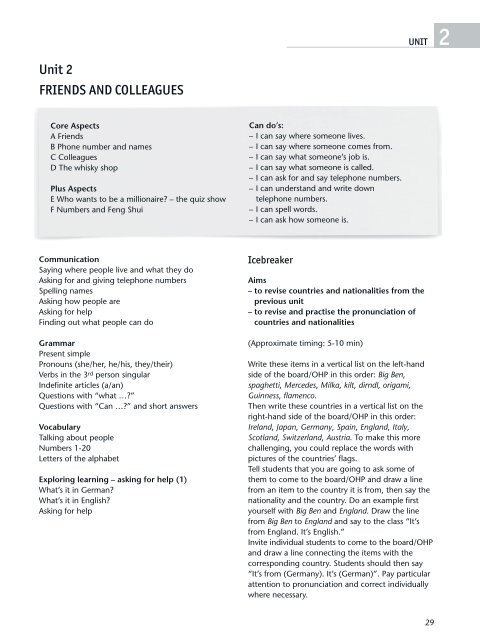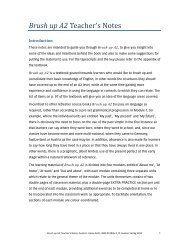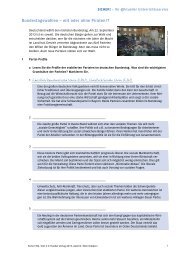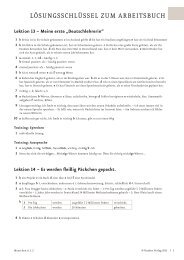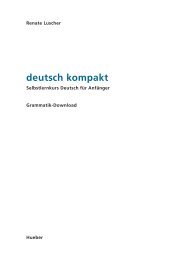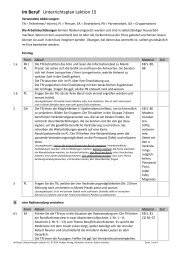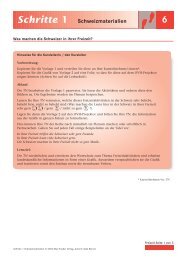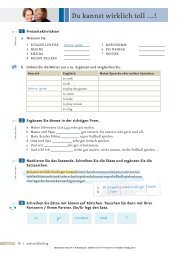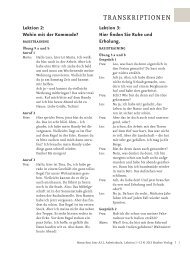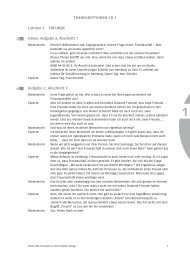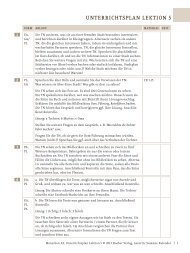Next A1 English - Hueber
Next A1 English - Hueber
Next A1 English - Hueber
Create successful ePaper yourself
Turn your PDF publications into a flip-book with our unique Google optimized e-Paper software.
UNIT 2<br />
Unit 2<br />
FRIENDS AND COLLEAGUES<br />
Core Aspects<br />
A Friends<br />
B Phone number and names<br />
C Colleagues<br />
D The whisky shop<br />
Plus Aspects<br />
E Who wants to be a millionaire? – the quiz show<br />
F Numbers and Feng Shui<br />
Can do’s:<br />
– I can say where someone lives.<br />
– I can say where someone comes from.<br />
– I can say what someone’s job is.<br />
– I can say what someone is called.<br />
– I can ask for and say telephone numbers.<br />
– I can understand and write down<br />
telephone numbers.<br />
– I can spell words.<br />
– I can ask how someone is.<br />
Communication<br />
Saying where people live and what they do<br />
Asking for and giving telephone numbers<br />
Spelling names<br />
Asking how people are<br />
Asking for help<br />
Finding out what people can do<br />
Grammar<br />
Present simple<br />
Pronouns (she/her, he/his, they/their)<br />
Verbs in the 3 rd person singular<br />
Indefinite articles (a/an)<br />
Questions with “what …?”<br />
Questions with “Can …?” and short answers<br />
Vocabulary<br />
Talking about people<br />
Numbers 1-20<br />
Letters of the alphabet<br />
Exploring learning – asking for help (1)<br />
What’s it in German?<br />
What’s it in <strong>English</strong>?<br />
Asking for help<br />
Icebreaker<br />
Aims<br />
– to revise countries and nationalities from the<br />
previous unit<br />
– to revise and practise the pronunciation of<br />
countries and nationalities<br />
(Approximate timing: 5-10 min)<br />
Write these items in a vertical list on the left-hand<br />
side of the board/OHP in this order: Big Ben,<br />
spaghetti, Mercedes, Milka, kilt, dirndl, origami,<br />
Guinness, flamenco.<br />
Then write these countries in a vertical list on the<br />
right-hand side of the board/OHP in this order:<br />
Ireland, Japan, Germany, Spain, England, Italy,<br />
Scotland, Switzerland, Austria. To make this more<br />
challenging, you could replace the words with<br />
pictures of the countries’ flags.<br />
Tell students that you are going to ask some of<br />
them to come to the board/OHP and draw a line<br />
from an item to the country it is from, then say the<br />
nationality and the country. Do an example first<br />
yourself with Big Ben and England. Draw the line<br />
from Big Ben to England and say to the class “It’s<br />
from England. It’s <strong>English</strong>.”<br />
Invite individual students to come to the board/OHP<br />
and draw a line connecting the items with the<br />
corresponding country. Students should then say<br />
“It’s from (Germany). It’s (German)”. Pay particular<br />
attention to pronunciation and correct individually<br />
where necessary.<br />
29
Aspect A Friends<br />
Aims<br />
– to practise reading for specific personal information<br />
– to introduce and practise the subject pronouns<br />
he/she/it and the possessive pronouns his/her<br />
– to introduce and practise the present simple in<br />
the 3 rd person singular with the “–s” ending<br />
– to introduce how to ask for words in <strong>English</strong><br />
(Approximate timing: 45 min.)<br />
<strong>A1</strong>a<br />
Play the recording once and let students decide in<br />
pairs where they think the music is from. If you<br />
have more able students, you could ask them to<br />
discuss their reasons briefly. Then ask a student for<br />
the answer.<br />
Tapescript / CD 1 Track 15<br />
“Mull o’ the Mountain” by Deirdre Campbell-Shaw<br />
Key<br />
from Scotland<br />
<strong>A1</strong>b<br />
Allow students a couple of minutes to complete the<br />
information, then check the answers together.<br />
Key<br />
Scotland; <strong>English</strong><br />
➜ Culture<br />
Scots has been officially recognised as a distinct<br />
language since 1998. It is the language perhaps<br />
best known through the work of the poet Robbie<br />
Burns. Gaelic (pronounced “gallic”) is a Celtic<br />
language still spoken by 58,650 people (2001<br />
General Census of Scotland), though some<br />
estimates are as high as 86,000 (2% of the<br />
population), mainly in the Outer Hebrides, the<br />
Western Isles, the Central belt, the northern<br />
Hebridean islands and the northern Highlands<br />
regions. For more information on Scotland<br />
generally, see www.visitscotland.com.<br />
A2a<br />
(15 min.)<br />
This activity practises reading texts for specific information.<br />
Advise students first to read each text all<br />
the way through quickly to get a general idea about<br />
what each one is about. Remind them that they<br />
needn’t understand every word. Then they should<br />
look back at each text and find the information<br />
which they need to complete the task.<br />
You should avoid answering queries about<br />
unfamiliar words at this stage as it is important for<br />
students to tackle this kind of task themselves to<br />
foster an atmosphere of independent learning.<br />
Activity A2c provides students with an opportunity<br />
to ask each other or you what the meaning of any<br />
unknown words is.<br />
Allow students about ten minutes to read the texts<br />
and complete the information. While students are<br />
working, walk around and help out where<br />
necessary. Then go through the answers together.<br />
Key<br />
name: Deirdre<br />
comes from: Edinburgh<br />
job: soprano singer<br />
lives in: 20 km from Hamburg<br />
married? no<br />
children? no<br />
favourite drink: Scotch<br />
name: Andy<br />
comes from: Shetland<br />
job: manager<br />
lives in: Hamburg<br />
married? yes<br />
children? yes, two<br />
favourite drink: tea<br />
Look together at the Focus on spoken <strong>English</strong> box<br />
which highlights the use of “great” in informal<br />
<strong>English</strong>. The word “great” is a “3-star” word<br />
according to the Bloomsbury Corpus of World <strong>English</strong>,<br />
which means that it appears in the 2,500 most<br />
frequently used words in the <strong>English</strong> language.<br />
For more information on the Bloomsbury Corpus<br />
of World <strong>English</strong> and the integration of 1-, 2-, and<br />
3-star words into the NEXT series, see the<br />
Introduction (p. 6 and p. 9).<br />
Read the Focus on grammar box together and<br />
make sure students understand that he/she/it is/isn’t<br />
is the verb to be in the 3 rd person singular form. To<br />
aid comprehension, ask students what the I and we<br />
30
PLUS UNIT 2<br />
Key<br />
fourteen<br />
oh/zero one seven two double six three nine<br />
five four one<br />
eighteen<br />
thirteen<br />
F2<br />
Students are provided with further practice of<br />
saying and understanding numbers. The activity is<br />
made more meaningful and authentic by including<br />
numbers with personal significance for the learners.<br />
They should first complete their own “number<br />
biography”, then find out their partner’s by asking<br />
“What’s your …?” and writing down the numbers<br />
as digits. Walk around and in particular make sure<br />
that students are saying the telephone numbers<br />
correctly (i.e. as individual digits).<br />
F3<br />
Students read the text to find out about lucky and<br />
unlucky numbers in different countries and answer<br />
the question. Again, remind students that they<br />
needn’t understand every word in the text, but<br />
should only look for the information to answer the<br />
question.<br />
F4a<br />
Tell students to scan through the text and first write<br />
down the digits. Then they should write the words<br />
beside each digit. Check the answers together by<br />
writing each number in words on the board/OHP.<br />
Key<br />
7 seven; 8 eight; 13 thirteen; 12 twelve;<br />
14 fourteen; 11 eleven; 15 fifteen; 4 four; 9 nine<br />
F4b<br />
This time, students need to read the text for more<br />
detail to complete the table. Allow them about<br />
5 minutes to find the numbers and countries and<br />
write them down in the table, then check the<br />
answers together.<br />
Key<br />
lucky numbers: 7 (Europe); 8 (China)<br />
unlucky numbers: 13 (many countries); 4, 7, 9<br />
(China)<br />
F5a<br />
Students should briefly discuss in pairs what they<br />
think are lucky and unlucky numbers in their<br />
respective countries. If possible, try to make sure<br />
that students from different countries work<br />
together.<br />
The emphasis here is on free speaking, so as you<br />
walk around, avoid correcting every minor error.<br />
After students have discussed together, ask a few<br />
individual students from different countries to say<br />
which numbers are lucky or unlucky in their<br />
countries. This helps broaden students’ cultural<br />
awareness and personalises the activity. It may even<br />
lead to some fruitful discussion as a class.<br />
F5b<br />
To find out the most popular number in the class,<br />
students could walk around and ask each other<br />
what their favourite number is, which they can jot<br />
down and report back on.<br />
Alternatively, you could do this as a class survey.<br />
Hand out small slips of paper to each student and<br />
ask them to write their favourite number on it. They<br />
should then give this to a “secretary”, a student<br />
volunteer or appointed by you. He/she should then<br />
read aloud each number on each slip of paper and<br />
you write them on the board/OHP.<br />
Extra materials<br />
There are extra materials and information for<br />
teachers at www.hueber.de/next. The web code for<br />
this unit which will take you directly to the relevant<br />
web pages is X<strong>A1</strong>T02.<br />
41


